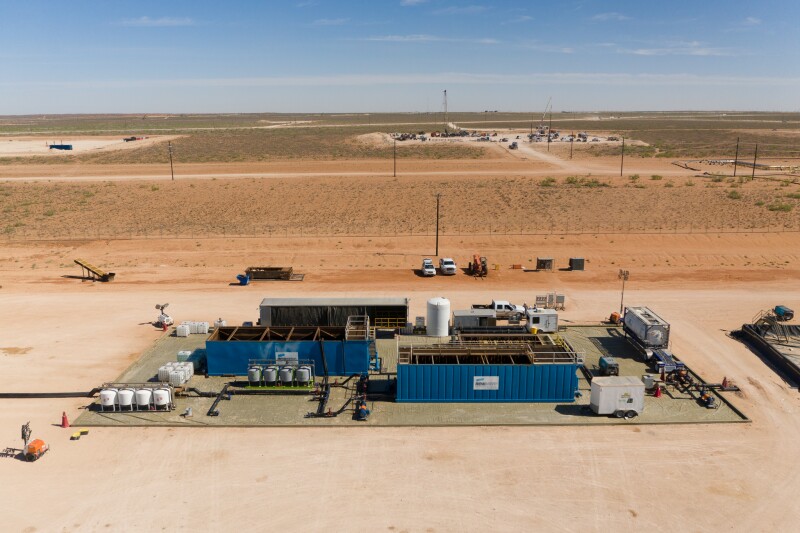Environmental, social and governance (ESG) has become an important aspect of water resource management in oil and gas operations in the Permian Basin. The financial benefits of ESG are improving efficiencies not only for oil and gas operators but also for service companies. The challenges that the oil and gas industry faces call for water-resource-management practices that bolster the bottom line, improve financial results, and produce environmental stewards and leaders in an ever-changing ESG environment.
Water resource management is playing an integral role as current completion operations get more complicated while increasing efficiencies throughout a development plan. With completions increasing to an average of 60 barrels per foot of horizontal lateral and total completion packages averaging 600,000 barrels per well, water resource management is adapting and changing to meet these new demands. Completion packages have increased substantially in the industry, and with the advent of simultaneous pressure pumping, increases of water rate deliveries are part of an ever-changing landscape in the Permian Basin. Cube development and multi-well-pad development have increased water demands to an all-time high, and the critical nature of the logistical component of water logistics is paramount.
One of the best ways to meet this demand is to use a resource that's readily available and already at the locations where needed. Recycling produced water from nearby infrastructure and reusing that water for completions has become the way forward for water resource management in the Permian Basin.
The Permian Basin is in a desert environment where groundwater and freshwater resources should be saved and utilized for local communities and agriculture. Using water that was once a waste product, recycling it, cleaning it up, and taking it back for completions is truly the best way to approach the ever-growing and changing water environment in the oil field.
Technology plays a huge role in cleaning this water and preparing it to be reused, recycled, and ready for a completion on the next pad. Using recycled water then becomes environmentally responsible by saving and protecting freshwater and groundwater resources.
Any of the groundwater and surface water that is used for oil and gas completions is completely removed from the hydrosphere. In an area plagued by droughts and with nation’s largest aquifer used by the agricultural industry, relying on a different source of water, i.e., recycled produced water, for completions is very environmentally sustainable.
Not only is there an opportunity to reduce the use of freshwater, there is also an opportunity of minimizing the amount of water injected into the ground to a saltwater disposal well (SWD)—thus reducing the seismic activity in deep SWD injectors.
The deep formations such as the Ellenberger and the Arbuckle have become very popular injection sites, but they sit on top of the Precambrian where a lot of faulting still exists. This faulting is becoming lubricated by the high injection rates, which is causing micro-seismic events across the mid-continent.
By taking steps to reuse this water rather than inject it, the industry is able to limit seismic events—which increases the social responsibility aspects of ESG. In addition, it shows the industry’s awareness of water resources and how they affect the communities that surround those resources.
Taking water from SWDs and reusing it for completions can be a tricky endeavor. The industry relies heavily on technology to make this a reality. Produced water is extremely variable throughout the day. Water resource management needs to handle variability on multiple locations and process this ever-changing water with a high degree of certainty that the effluent from a recycling plant maintains the highest water-quality standards. Technology has helped considerably to achieve this goal. Automation and controls, dissolved air flotation technologies, advanced filtration technologies, highly intelligent supervisory control and data acquisition (SCADA), and reporting technologies have advanced so tremendously in the last 2 years that they have become a cornerstone for successfully recycling produced water.
Costs for recycling produced water have come down in recent years for all technologies, making the practice a competitive and viable alternative for completions water.
A typical water resource operator in the field has a fundamental understanding of oxidants, coagulants, flocculants, and other chemistries that make up completion fluids. This new water logistics process demands a diverse set of highly skilled employees as companies look for young science-minded and engineering-minded employees to be a part of this growing aspect of the oil and gas community. There are now more instrumentation and electrical (I&E) technicians, computer programmers, electricians, and chemical engineers who are employed in the water resources industry for recycling produced water, and the need is growing—so there is an increase in recruitment nationwide to fill these positions.
As this plentiful waste product continues to be recycled and be reused, ESG initiatives will continue to grow. The oil and gas industry as a whole is becoming more sustainable, more diverse, and more environmentally responsible. Currently, only about 10% of the produced water in the Permian Basin is recycled and reused for well completions; the way forward will be to reuse and recycle the vast majority of the produced water in the Permian Basin and in the oil and gas industry at large. This is a tremendous and exciting time for technological advancements in water resources in the ESG world we live in.


